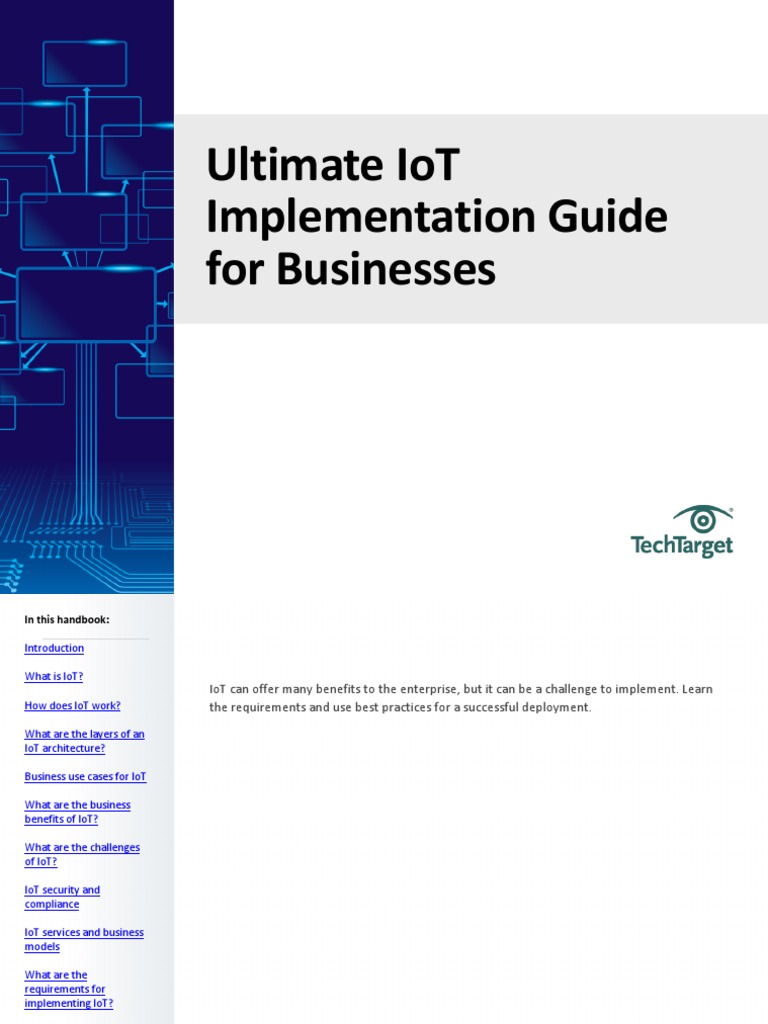Ultimate IoT Implementation Guide For Businesses: Transforming Operations With Cutting-Edge Technology
In today's rapidly evolving digital landscape, the Internet of Things (IoT) has emerged as a game-changer for businesses across industries. IoT implementation offers unparalleled opportunities to enhance operational efficiency, improve decision-making, and create new revenue streams. As organizations strive to stay competitive, understanding and leveraging IoT technologies has become essential.
The integration of IoT into business processes can revolutionize how companies operate. From real-time data collection and analysis to automation and predictive maintenance, the potential benefits are immense. However, successful IoT implementation requires a strategic approach, careful planning, and a deep understanding of the technology and its applications.
This comprehensive guide will walk you through everything you need to know about implementing IoT in your business. Whether you're a small startup or a large enterprise, this ultimate IoT implementation guide will provide actionable insights, best practices, and expert advice to help you harness the power of IoT effectively.
Read also:Harley Quinn Actor Name A Comprehensive Guide To The Iconic Characters Portrayals
Table of Contents:
- Introduction to IoT
- Business Benefits of IoT
- Steps for IoT Implementation
- Security and Privacy Considerations
- Choosing the Right IoT Solutions
- Budgeting for IoT Projects
- Real-World IoT Use Cases
- The Future of IoT in Business
- Common Challenges and Solutions
- Conclusion
Introduction to IoT
The Internet of Things (IoT) refers to the network of interconnected devices that communicate and exchange data over the internet. These devices range from simple sensors to complex industrial machinery, all equipped with embedded sensors, software, and connectivity capabilities. IoT enables businesses to collect and analyze vast amounts of data in real-time, leading to smarter decision-making and optimized operations.
How IoT Works
IoT systems consist of several components, including sensors, actuators, communication protocols, and cloud platforms. Sensors collect data from the environment, which is then transmitted to a central system for processing and analysis. Actuators perform actions based on the insights derived from the data. Communication protocols ensure seamless data exchange between devices and platforms.
Key IoT Components
- Sensors: Capture data from the physical world.
- Gateways: Facilitate communication between devices and cloud platforms.
- Cloud Platforms: Store and analyze data for actionable insights.
- Applications: Provide user interfaces for monitoring and controlling IoT systems.
Business Benefits of IoT
Implementing IoT in your business can lead to significant improvements in various areas. Here are some of the key benefits:
Operational Efficiency
IoT enables businesses to automate repetitive tasks, monitor equipment performance, and streamline workflows. This results in reduced downtime, lower operational costs, and increased productivity.
Enhanced Customer Experience
By leveraging IoT data, companies can gain deeper insights into customer preferences and behaviors. This allows them to personalize products and services, improving customer satisfaction and loyalty.
Read also:Danielle Busby Clothing Line Elevating Style With Timeless Elegance
New Revenue Streams
IoT opens up opportunities for businesses to develop innovative products and services. For example, manufacturers can offer predictive maintenance services based on real-time data from IoT-enabled devices.
Steps for IoT Implementation
Successfully implementing IoT requires a structured approach. Follow these steps to ensure a smooth transition:
Define Objectives
Start by identifying your business goals and how IoT can help achieve them. Clearly define the problems you want to solve or the opportunities you want to capitalize on.
Select the Right Devices
Choose IoT devices that align with your objectives and meet your specific requirements. Consider factors such as compatibility, scalability, and ease of integration with existing systems.
Plan for Security
Security should be a top priority when implementing IoT. Implement robust security measures to protect sensitive data and prevent unauthorized access.
Security and Privacy Considerations
IoT systems handle vast amounts of data, much of which may be sensitive or confidential. Ensuring the security and privacy of this data is crucial.
Data Encryption
Encrypt data both in transit and at rest to safeguard it from unauthorized access. Use industry-standard encryption protocols to ensure maximum protection.
Access Control
Implement strict access control policies to ensure that only authorized personnel can access IoT systems and data. Regularly review and update these policies as needed.
Choosing the Right IoT Solutions
With numerous IoT solutions available, selecting the right one can be challenging. Consider the following factors when making your decision:
Scalability
Choose solutions that can grow with your business. Ensure that the IoT platform you select can accommodate additional devices and data as your needs expand.
Integration
Ensure that the IoT solution integrates seamlessly with your existing systems and processes. This will minimize disruptions and ensure a smooth transition.
Budgeting for IoT Projects
IoT implementation requires significant investment in hardware, software, and infrastructure. Careful budgeting is essential to ensure the project's success.
Initial Costs
Factor in the costs of purchasing devices, setting up infrastructure, and hiring experts for installation and configuration.
Ongoing Expenses
Consider the costs of maintaining and upgrading the IoT system, including software updates, hardware replacements, and staff training.
Real-World IoT Use Cases
IoT has been successfully implemented in various industries, yielding impressive results. Here are some examples:
Smart Manufacturing
Manufacturers use IoT to monitor production lines, predict equipment failures, and optimize resource utilization. This leads to increased efficiency and reduced costs.
Healthcare
In healthcare, IoT devices enable remote patient monitoring, improving patient outcomes and reducing hospital stays. Wearable devices provide real-time health data, empowering patients to take charge of their well-being.
The Future of IoT in Business
The future of IoT in business is bright, with advancements in technology driving further innovation. Expect to see increased adoption of AI-powered IoT solutions, enhanced connectivity through 5G networks, and greater emphasis on security and privacy.
AI and IoT Convergence
The integration of AI with IoT will enable more intelligent and autonomous systems, capable of making decisions without human intervention.
Edge Computing
Edge computing will play a crucial role in IoT, allowing data processing to occur closer to the source. This reduces latency and improves real-time decision-making capabilities.
Common Challenges and Solutions
While IoT offers numerous benefits, it also presents challenges that need to be addressed. Here are some common challenges and their solutions:
Interoperability
Challenge: Ensuring that different IoT devices and systems can work together seamlessly.
Solution: Use standardized communication protocols and platforms that support interoperability.
Data Overload
Challenge: Managing and analyzing the vast amounts of data generated by IoT devices.
Solution: Implement advanced data analytics tools and machine learning algorithms to extract meaningful insights.
Conclusion
In conclusion, IoT implementation can transform businesses by enhancing operational efficiency, improving customer experience, and creating new revenue streams. However, successful IoT adoption requires careful planning, strategic execution, and a focus on security and privacy. By following the steps outlined in this ultimate IoT implementation guide, businesses can harness the full potential of IoT and stay ahead in the competitive landscape.
We encourage you to share your thoughts and experiences with IoT implementation in the comments section below. For more insights into technology and business innovation, explore our other articles on the website. Thank you for reading!

